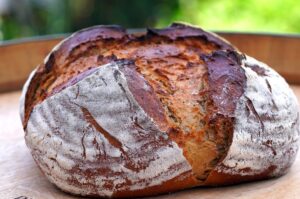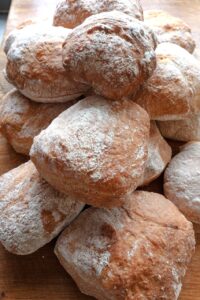 Bread has been a staple of human diets for generations. Artisan bread-making is an age-old tradition that celebrates craftsmanship, simplicity, and the deep connection between the baker and their craft. However, it’s not just nourishing the body, it’s a work of art. So, let’s delve into the world of artisan bread, exploring its rich history, unique characteristics, and the process of creating these edible masterpieces.
Bread has been a staple of human diets for generations. Artisan bread-making is an age-old tradition that celebrates craftsmanship, simplicity, and the deep connection between the baker and their craft. However, it’s not just nourishing the body, it’s a work of art. So, let’s delve into the world of artisan bread, exploring its rich history, unique characteristics, and the process of creating these edible masterpieces.
A Brief History
Bread can be traced back to ancient civilizations, where it was crafted using simple ingredients: flour, water, and naturally occurring yeast. However, with industrialization, bread production became mass-produced, leading to the decline of traditional bread making. In the 1980’s, a revival of artisan bread-making began in the United States. People began seeking out the authentic flavors and textures that can only be achieved through slow fermentation and careful craftsmanship. As a result, artisan bakeries started popping up, emphasizing the use of high-quality ingredients and traditional baking techniques. Today, artisan bread-making is not just a return to the past, it’s a culinary movement.
The Essence of Artisan Bread
What sets this bread apart from its commercial counterparts? Several characteristics define the art of artisan bread:
- Simple Ingredients: High-quality ingredients such as: flour, water, salt, and yeast are used. These simple components allow the flavor of the bread to shine.
- Handcrafted: Artisan bread is mixed, shaped, and baked by hand. The baker’s touch and intuition are essential in achieving the desired texture and flavor.
- Long Fermentation: Allow the dough to ferment slowly, sometimes over several hours or even days. As a result, the bread’s flavor and texture are enhanced. Additionally, long fermentation improves digestibility of bread.
- Crust and Crumb: Artisan bread boasts a rustic, often thick, and crunchy crust with a tender, airy crumb. This contrast between the two is one of its defining features.
 Varied Shapes: Bakers often create a wide variety of bread shapes, from baguettes (long) and boules (round) to batards (oval or oblong) and ciabattas (typically roll sized squares or rectangles). Each shape has its unique characteristics and uses.
Varied Shapes: Bakers often create a wide variety of bread shapes, from baguettes (long) and boules (round) to batards (oval or oblong) and ciabattas (typically roll sized squares or rectangles). Each shape has its unique characteristics and uses.
The Art of the Bake
Creating artisan bread is a labor of love that demands skill, patience, and elevation adjustments. Here is a glimpse into the process:
- Mixing: Use high-quality flour, water, salt, and yeast to form a shaggy dough. Allow this mixture to rest and hydrate.
- Fermentation: The dough undergoes a slow fermentation process, often lasting several hours or overnight. This period allows the yeast to develop complex flavors and create it’s signature airy crumb.
- Shaping: Shape the dough into the desired form. Pay careful attention to developing enough surface tension so that the loaf holds it’s shape.
- Proofing: Let the dough proof/rise. This helps develop structure, crust and crumb.
- Baking: Bake dough at high temperatures. This is essential to the development of its distinct crust and crumb. A cast iron Dutch oven or baking stone is typically used to bake these breads.
The Appeal
Artisan bread represents a return to the fundamentals of baking, highlighting the purity of ingredients and the expertise of the baker. It’s a testament to the enduring appeal of time-honored traditions and the desire for real, honest flavors. Therefore, enjoying a slice of freshly baked artisan bread is not just about nourishment; it’s a sensory experience, connection to the past, and a celebration of the craft.
In a world of culinary arts, artisan bread-making stands as a reminder that simplicity and tradition can yield some of the most extraordinary results. So, the next time you tear into a warm, fragrant loaf of bread, take a moment to savor the taste, and the centuries-old artistry that has gone into creating this edible masterpiece.

